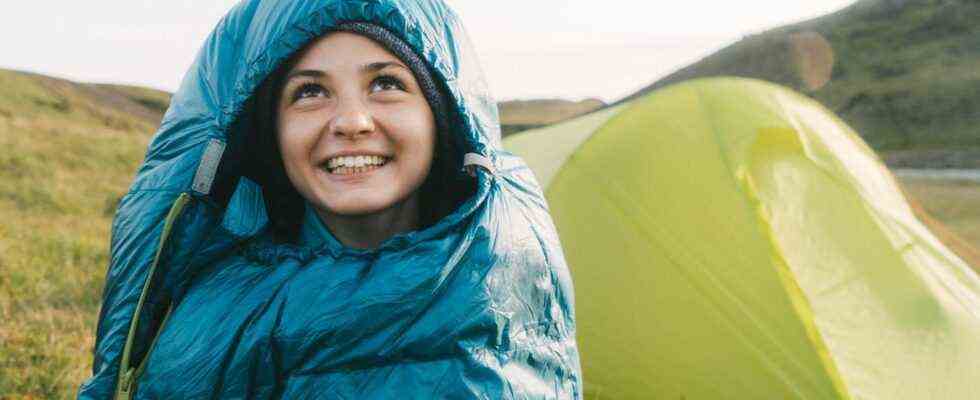Trekking
Ultralight sleeping bag: what really counts when buying – and how to care for it
You should choose your luggage carefully, especially on longer trekking tours. With an ultralight sleeping bag, bargain hunters protect their backs and still have a comfortable night.
© Oleh_Slobodeniuk / Getty Images
It’s the big crux of trekking and camping: The luggage should be as light as possible, but you don’t want to freeze at night either. The solution: an ultra-light sleeping bag. What the high-tech bed has to be able to do for on the go and how to properly care for it.
Did you know that a 75-year-old sleeps almost a third of his or her life? Our body spends a proud 24 years resting, refueling and regenerating for everyday life. Usually we sleep in cozy beds on more or less good mattresses. But what would tent camps, camping holidays or trekking tours be without the good old sleeping bag? They used to be made of cotton and hit the office with luggage and ruined your back in the long run. In the meantime, the blanket has developed into a real functional gadget for on the go. Some models weigh no more than a piece of butter. Is that at the expense of sleeping comfort? What must a Ultralight sleeping bag be able? What should you pay attention to when buying and what do the printed temperature information mean? Practical tips for anyone planning an outdoor adventure in 2022. In addition: alternatives to the ultralight sleeping bag and important care tips.
Ultralight sleeping bag: this is important when buying
1. Purpose of use
In the winter months and on mountain tours, ultralight sleeping bags are not an option. Here you should use more robust models, which are usually much heavier, but also protect against the cooler weather conditions. Especially in spring and summer, however, the lightweights among the sleeping bags strikes. In addition to a tent, sleeping mat and other equipment, the ultralight sleeping bag is the most important gadget for multi-day tours. Especially so-called ultra-light trekkers, who travel through nature with less than 5 kilograms of luggage, cannot avoid the little miracle beds to go.
2. Temperature range
In addition to the weight, the temperature range specified by the manufacturer should be observed. It is usually given with three values.
- Comfort area (TCom)
- Lower limit range (TLim)
- Survival or Extreme Range (TExt)
The following applies: Area 1 indicates the (outside) temperature up to which the sleeping bag will keep the entire body comfortably warm. The lower limit area stands for just enough protection. The information for TExt shows the limit to the risk of hypothermia. So it is best to check in advance which weather conditions and temperatures will prevail in the region of your holiday at the time of travel and then select the sleeping bag with the corresponding information on the temperature range.
3. Material and filling
As with many other outdoor products, the same applies to sleeping bags: the lighter, the more expensive. In the case of ultralight sleeping bags, the inner values make all the difference. Because the sleeping bags are either filled with synthetic fibers or down. The latter are significantly lighter and more powerful. The cover is usually made of nylon, a microfiber fabric or polyester. Here, too, the following applies: the more functional the material, the more expensive the matter becomes. If you already know that you will spend the night outdoors, a moisture-repellent and windproof outer material should be worth it. Saving is a bad idea at this point.
When buying a down sleeping bag, keep this in mind too RDS seal. The so-called Responsible Down Standard is independent, voluntary and global. Its purpose is to guarantee that the animals from which the down comes are protected and treated ethically. As with this 700 gram light Model by Forclaz.
Ultralight backpack: care tips
No matter how you turn it around: Everyone sweats while sleeping. Especially in sleeping bags, where little or no air can circulate. Therefore, ultralight sleeping bags should not only be aired after each night, but should also be washed every now and then. Rule of thumb: If you sleep without a ticking, you should wash your sleeping bag after about 60 nights. If you use an inlay, you can snuggle up in your sleeping bag for 120 nights before you need to wash. As a general rule, sleeping bags should be washed as rarely as possible. The more often they end up in the washing machine, the faster the insulation ability deteriorates. Especially in the case of down sleeping bags, the puffiness is severely impaired when washing.
This is important when caring for ultralight sleeping bags:
- Repair damage and cracks before washing
- close all Velcro and zip fasteners
- Pre-treat small stains with detergent before washing
- Follow the manufacturer’s washing instructions
- for down sleeping bags only special down detergent use
- Never use fabric softener
- Select the delicate / wool wash program and the lowest spin setting
- Tip: Only one sleeping bag per wash cycle in the drum (down takes up a lot of space)
Much less sensitive are ultralight sleeping bags filled with synthetic fibers like the one Exosphere from Deuter. Basically, however, the same rules apply as for down sleeping bags. Instead of the down detergent, a synthetic sleeping bag should come with a Detergent for synthetic fiber fillings getting cleaned. Alternatively, hand washing with plenty of lukewarm water in the bathtub can also help. Stubborn stains should also be treated with detergent beforehand.
Important: Particularly with down sleeping bags, you should make sure that they are 100 percent dry before they are stored for a long time. This works best in a large drum dryer (max. 40 degrees Celsius) and works even better if you add three clean tennis balls.
You might also be interested in:
This article contains so-called affiliate links. Further information are available here.


